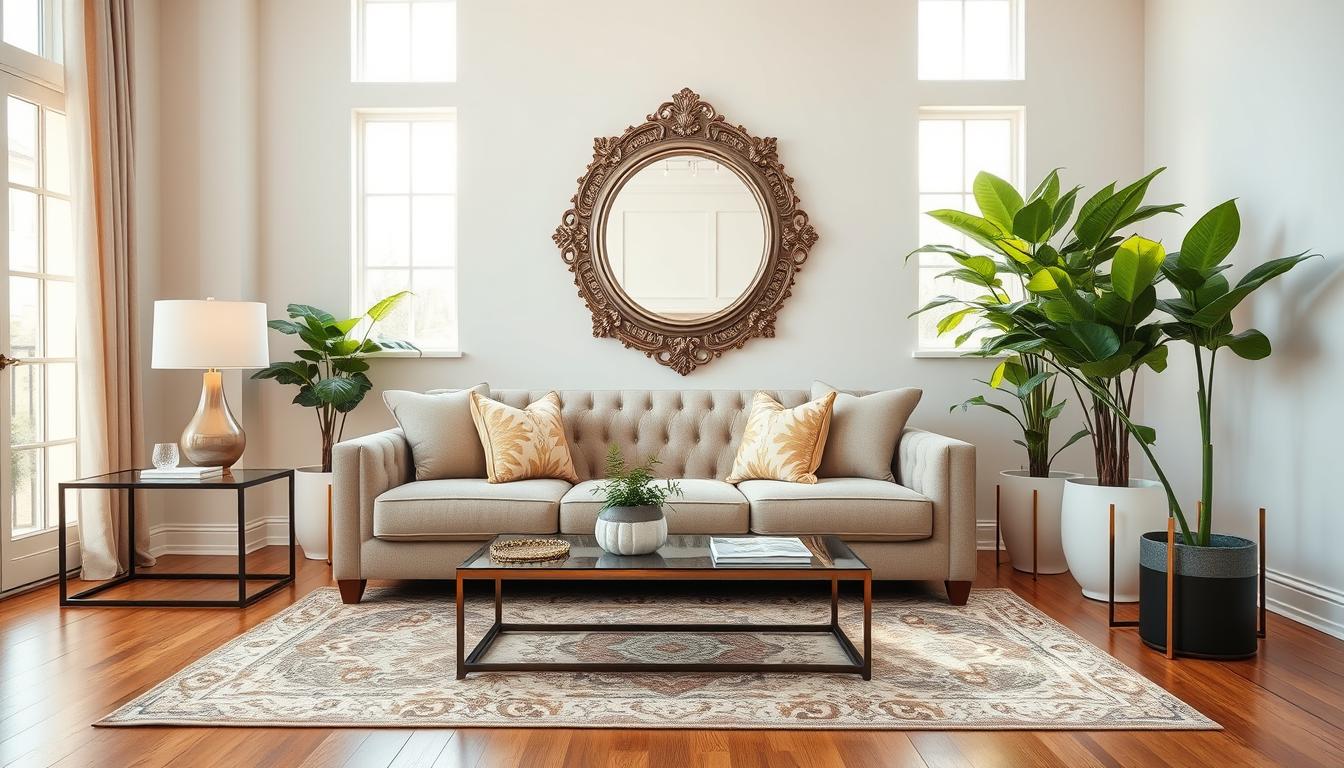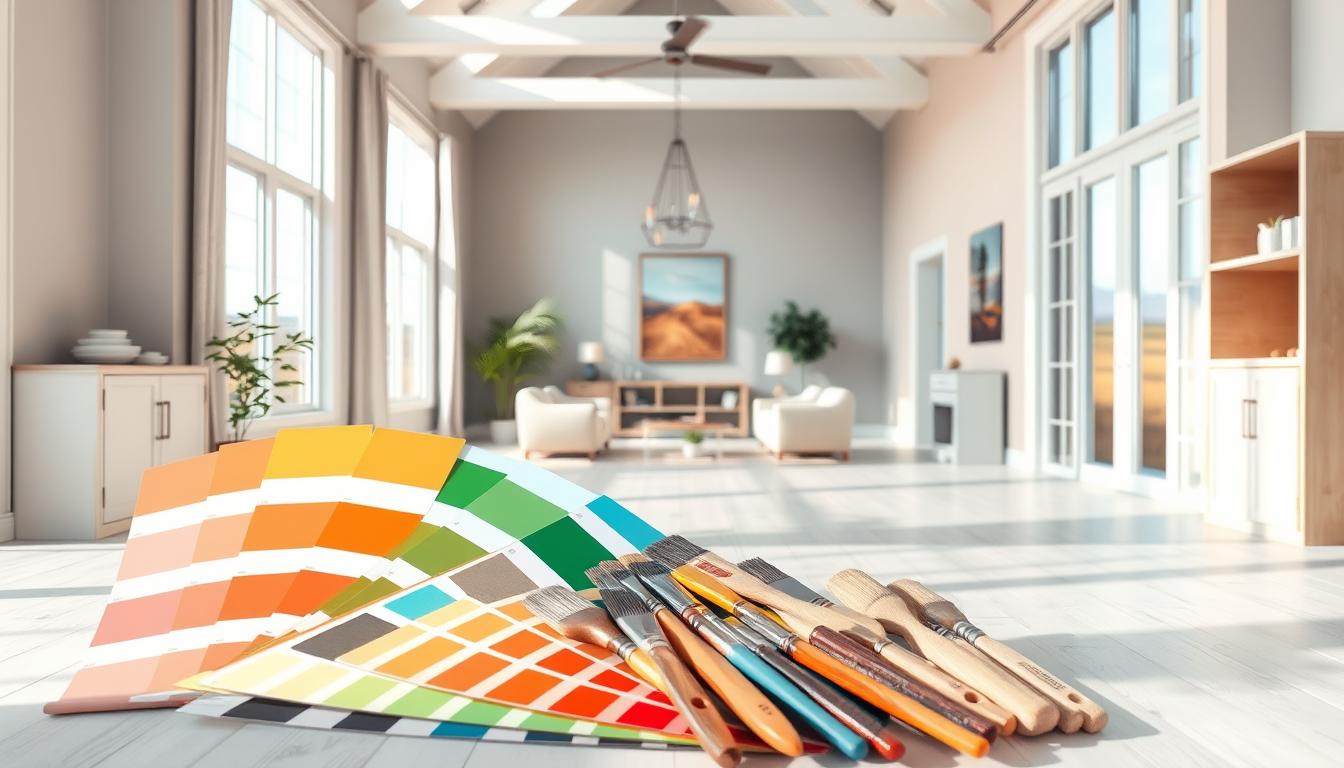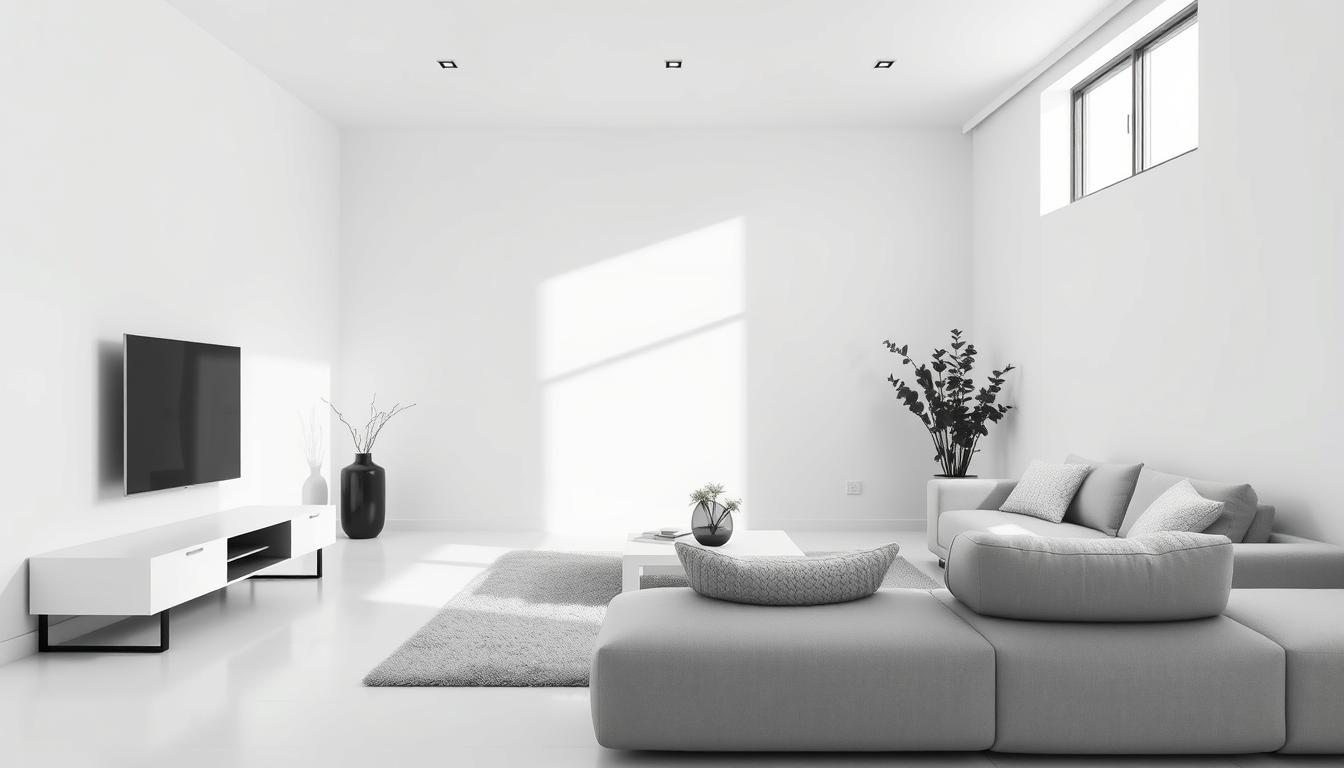Did you know a well-designed living space can boost your home’s value by up to 10%? This fact shows how much interior design can change our homes. We think every homeowner should have a beautiful and useful space that shows who they are.
Our interior decorating ideas aim to inspire and help you change your living areas. Whether you want to update one room or redo your whole house, we offer the ideas and advice you need.
Key Takeaways
- Discover the latest trends in home interior decorating ideas.
- Learn how to choose the perfect color palette for your space.
- Explore innovative ways to maximize your living area.
- Understand the importance of lighting in interior design.
- Get tips on selecting furniture that complements your home’s style.
Embracing Minimalism for a Fresh Look
Minimalism can turn your home into a peaceful and stylish place. It’s about keeping things simple and focusing on what’s important. This way, you get a modern look that’s both calm and beautiful.
Understanding Minimalist Principles
Minimalist design is all about simplicity. It means getting rid of things you don’t need. It’s about clean lines, simple shapes, and a few colors.
To get a minimalist look, follow these tips:
- Clear out clutter and keep only what’s essential.
- Choose a neutral color scheme for a calm feel.
- Pick furniture that does more than one thing.
Color Schemes for Minimalist Design
Choosing the right colors is key for a minimalist look. Neutrals like white, beige, and gray are popular. They make your space feel clean and calm.
For a modern touch, add a pop of color with accessories or a bold piece of furniture. For more ideas, check out our article on top 10 interior home decor for a stylish space.
Here are some color schemes to try:
- Monochromatic: Use different shades of one color for a unified look.
- Neutral with a Pop of Color: Add a bold color to a neutral background.
- Soft Pastels: Use soft, muted pastel colors for a calming effect.
Furniture Choices for a Clean Aesthetic
Furniture is crucial for a minimalist look. Look for pieces that are simple, functional, and uncluttered. Don’t overdo it with too many items. Instead, choose a few pieces that do it all.
Here are some furniture picks for a clean look:
- A sleek, low-profile sofa in a neutral color.
- A minimalist coffee table with clean lines.
- A storage bed to keep clutter away.
Incorporating Bold Colors into Your Space
Adding bold colors to your home decor can really change things. It brings energy and vibrancy to your rooms. Bold colors can make a room stand out, creating a focal point that grabs attention and sparks conversation.
Choosing the Right Accent Wall
An accent wall is a smart way to use bold colors without feeling overwhelmed. Think about the room’s lighting and the colors around it. A bold color on a well-lit wall can look amazing.
For example, a deep blue accent wall in a bright living room can feel cozy and classy. A bright yellow accent wall in a kitchen can make it feel cheerful and welcoming.
Color Combinations That Work
Choosing the right bold colors to go together is key. Here are some color combos that work well:
| Color 1 | Color 2 | Effect |
|---|---|---|
| Navy Blue | Bright Yellow | Contrasting and Energetic |
| Deep Red | Soft Pink | Romantic and Sophisticated |
| Emerald Green | Crisp White | Fresh and Elegant |
Accessories for a Pop of Color
Accessories are also great for adding bold colors. Think throw pillows, blankets, and vases. These items can add a burst of color to any room.
For instance, colorful throw pillows can brighten up a neutral sofa. A bold-colored vase can be a standout on a coffee table or side table.
By using bold colors in accent walls, color combos, and accessories, you can make a space that’s unique and eye-catching. It shows off your personality.
Creating Cohesion with Design Themes
Design themes can make your living space feel welcoming and balanced. They help tie together different parts of your home. This creates a unified look that enhances your space.
Exploring Popular Design Themes
There are many design themes to pick from, each with its own style. Some favorites include:
- Modern Minimalism: It’s all about clean lines, simple designs, and being practical.
- Industrial Chic: It uses exposed brick, metal, and old wood for a unique look.
- Coastal Cool: It’s all about light colors, natural textures, and sea-inspired touches.
How to Mix and Match Themes
Mixing themes can add character to your space. Here’s how to do it well:
- Look for common colors or textures in different themes.
- Choose a main theme and add touches from others.
- Pair bold pieces with calm backgrounds.
Creating a Style Guide for Your Home
A style guide helps keep your home’s design consistent. It outlines the key elements of your theme, like:
- Color schemes and palettes.
- Furniture styles and materials.
- Textiles and patterns.
- Decorative accents and accessories.
Having a style guide ensures your home looks cohesive, even when you update it.
The Power of Textures in Home Décor
Using textures can make your home look better and feel more welcoming. They add depth and emotion, making your space feel like home. This makes your home feel more inviting and personal.
Different Types of Textures to Consider
There are many textures to choose from. Natural textures like wood and stone add warmth. Man-made textures like glass and metal bring a modern feel. Soft textures from fabrics and rugs make rooms cozy.
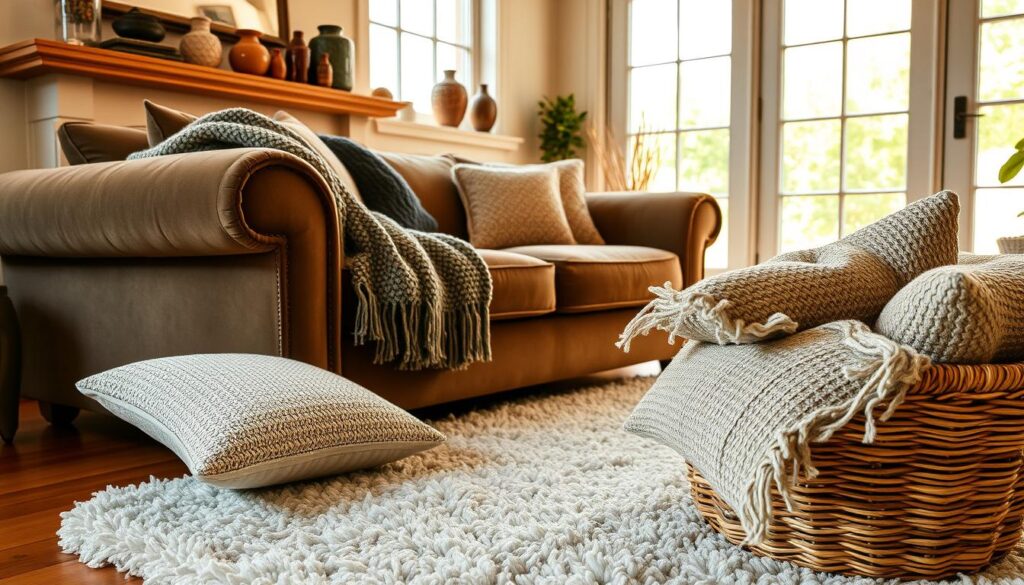
How to Layer Textures Effectively
Layering textures is an art. Start with a main texture, like a neutral sofa. Then add textures like throw pillows and rugs. This mix creates interest but avoid too many.
Stick to three main textures and use others as accents. For example, a leather sofa, a woven rug, and velvet pillows create a rich look.
Textured Accessories to Enhance Visual Interest
Textured accessories add personality to your space. Use items like woven baskets and textured vases for interest. Throw blankets with different textures add warmth.
Choose accessories that complement your space’s textures. A wooden coffee table and a glass vase make a striking contrast.
Bringing Nature Indoors: Biophilic Design
By embracing biophilic design, we can make our indoor spaces beautiful and calming. This design philosophy connects us with nature. It uses houseplants and natural materials to enhance our living areas.
Biophilic design is more than a trend. It’s a way to improve our health and work better. Let’s look at how we can bring these benefits into our homes.
Advantages of Biophilic Design
Adding biophilic elements to our homes can greatly improve our well-being. Some key benefits include:
- Improved air quality thanks to houseplants that clean the air.
- Enhanced mental health and less stress by bringing nature inside.
- More productivity and focus, which is great for home workspaces.
For more ideas on adding natural elements to your home, see our guide on creating a Java-inspired home interior.
Best Houseplants for Indoor Spaces
Picking the right houseplants is key for biophilic design. Some top choices are:
- Snake Plant: It purifies the air and is easy to care for.
- Spider Plant: Simple to care for and perfect for hanging baskets.
- Peace Lily: Elegant and great at cleaning the air.
Natural Materials for a Fresh Feel
Using natural materials adds to the biophilic feel of your home. Consider:
- Reclaimed wood for furniture or flooring.
- Stone or brick accents for texture and interest.
- Natural fibers like wool or jute for rugs and upholstery.
By carefully choosing these elements, we can make our homes more harmonious and refreshing. This connects us with nature.
Enhancing Functionality with Space Planning
Well-thought-out space planning can really improve your living space. It balances beauty with function. This way, your home looks great and feels comfortable.
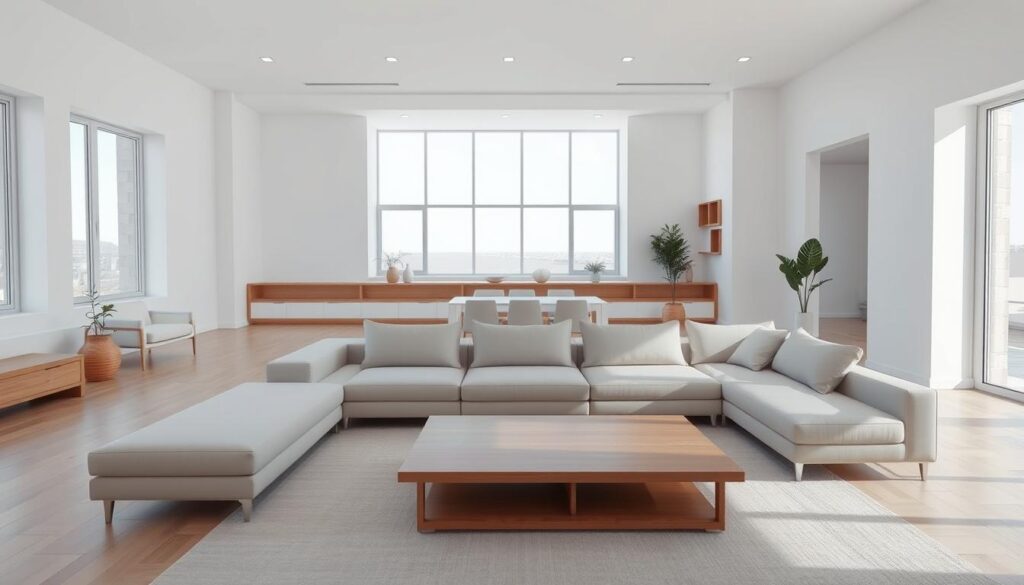
Effective Room Layouts
A good room layout is key to space planning. It’s about knowing what each room is for and setting it up right. For example, a living room should be set up for talking and relaxing.
Make a focal point, like a fireplace, and arrange furniture around it. This makes the room cozy and welcoming.
Think about how people will move around in the room. Leave enough space between furniture for easy movement. This makes the room more functional and peaceful.
Furniture Arrangement Tips
Furniture arrangement is crucial in space planning. It’s not just about fitting furniture; it’s about creating a layout that works. A good tip is to balance the room with furniture.
For example, if you have a big sofa, balance it with something big on the other side. This makes the room look balanced.
Make sure the furniture arrangement supports the room’s purpose. For example, a desk in a home office should be set up for focus and productivity.
Utilizing Vertical Space Creatively
Using vertical space is a smart way to make your home more functional. Shelves, cabinets, and tall furniture can make a room feel bigger. They also draw the eye up, making ceilings seem higher.
Choose furniture that fits the room’s scale. Tall, slim bookshelves are great for saving floor space. Wall-mounted desks or fold-down tables are perfect for small areas, using space efficiently.
Personalized Decor: Making it Uniquely Yours
Making your home truly yours is more than picking furniture and colors. It’s about adding personalized decor that tells your story.
Personalized decor lets you show off your personality and style. We’ll look at how custom art, DIY projects, and family heirlooms can make your home special.
Custom Art and Photographs
Custom art and photos are great for personalizing your space. They add beauty and remind you of special moments.
Think about getting a local artist to create something for you. Or, make your own art that shows your style. A custom painting or a framed photo can be a room’s centerpiece.
DIY Projects for Unique Touches
DIY projects are a fun way to add unique touches to your home. You can make everything from furniture to decorations.
Here are some DIY ideas:
- Make a gallery wall with family photos and art
- Create your own throw pillows and blankets
- Give old furniture a new life
Family Heirlooms in Modern Spaces
Adding family heirlooms to your modern decor brings history and depth. It’s a way to honor your heritage.
| Heirloom | Modern Twist |
|---|---|
| Vintage Clock | Repaired and repainted to match contemporary decor |
| Antique Furniture | Reupholstered with modern fabrics |
| Family Photographs | Printed in modern frames or canvas |
By using custom art, DIY projects, and family heirlooms, you can make a home that’s beautiful, meaningful, and uniquely yours.
Lighting: The Unsung Hero of Interior Design
Lighting is a key part of interior design, changing a space’s feel. It can make a room cozy or bright, depending on the lighting used.
Types of Lighting Options
There are many lighting types, each for a specific use. Ambient lighting lights up the whole room. Task lighting helps with activities like reading. Accent lighting draws attention to certain spots.
Choosing the right fixtures is important. Options include ceiling lights, table lamps, and wall sconces. They should match your home’s style.
Layering Light for Ambiance
Layering light creates a beautiful and functional space. It mixes different light sources for a balanced look. This adds depth and interest.
Start with ambient lighting as the base. Add task lighting where needed. Then, use accent lighting to highlight features.
Incorporating Natural Light
Natural light makes our homes feel better and saves on artificial lighting. We can use sheer curtains and mirrors to reflect sunlight.
Tips for Maximizing Natural Light:
- Keep windows clear for sunlight.
- Place mirrors opposite windows to reflect light.
- Use light colors to reflect sunlight.
By using natural and artificial light, we can make our homes warm and inviting.
Sustainable Decorating Choices
Decorating our homes can help the environment. Making sustainable choices benefits both our planet and our living spaces.
Eco-Friendly Materials
Using eco-friendly materials is key in sustainable decorating. Options like bamboo, reclaimed wood, and low-VOC paints are great. They’re good for the planet and add a special touch to our homes.
Here are some eco-friendly materials to think about:
- Bamboo flooring
- Reclaimed wood furniture
- Low-VOC paints
- Recycled glass countertops
Repurposing and Upcycling Ideas
Repurposing and upcycling breathe new life into old items. It’s a creative way to reduce waste and add character. For example, turning an old ladder into a bookshelf or using vintage jars for storage.
- Turn old pallets into coffee tables
- Use vintage windows as room dividers
- Convert old mason jars into pendant lights
Energy-Efficient Lighting Solutions
Energy-efficient lighting is crucial for sustainable decorating. LED bulbs, smart lighting, and solar lights are great choices. They save energy and make our homes look modern and sleek.
| Lighting Option | Energy Efficiency | Cost-Effectiveness |
|---|---|---|
| LED Bulbs | High | Yes |
| Smart Lighting Systems | High | Yes |
| Solar-Powered Lights | Very High | Yes |
By choosing these sustainable decorating options, we can make our homes better for the environment and more beautiful.
Smart Home Integration in Interior Design
Smart home technology is changing how we design our homes. It makes our homes more comfortable, efficient, and tailored to our needs. By adding technology to our living spaces, we unlock new ways to live and interact with our homes.
Advantages of Smart Technology
Smart technology brings many benefits to our homes. Enhanced convenience is a big plus, as we can control lights, temperature, and security with one device. It also helps us save energy, as devices use less power when not in use.
- Improved home security through smart locks and surveillance cameras
- Enhanced entertainment experiences with smart TVs and sound systems
- Better energy management through smart thermostats and lighting
Must-Have Smart Home Devices
There are key devices to consider for smart home integration. Smart speakers like Amazon Echo or Google Home act as central hubs. Smart thermostats like Nest or Ecobee learn our temperature preferences and save energy.
- Smart lighting systems for customizable ambiance
- Smart security cameras for enhanced safety
- Smart door locks for keyless entry and improved security
Blending Technology with Design
One challenge is making technology fit with our home’s design. We can choose devices that match our decor. For example, picking smart light bulbs that fit our existing lights or smart thermostats with modern designs.
By carefully adding smart technology to our design, we create spaces that are both beautiful and functional. They meet our needs and are highly responsive.
Seasonal Decor: Refreshing Your Space Throughout the Year
Our homes show off our personal styles, from minimalism to smart tech. Seasonal decor is a great way to keep your home feeling new and exciting. Just a few changes each year can refresh your home’s look and match the seasons.
Tips for a Seamless Transition
For easy seasonal changes, choose decor that’s easy to switch. Try swapping throw pillows, blankets, or adding seasonal flowers. For holidays, pick timeless pieces like elegant ornaments or quality decorative accents.
Creating a Timeless Base
Seasonal decor is fun, but a timeless look is key. Invest in classic furniture and neutral colors that stay in style. This base lets you add seasonal decor without overwhelming your space, making it welcoming and balanced.

